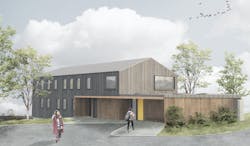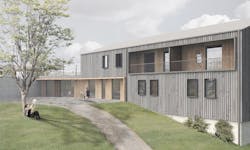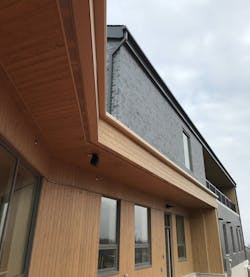I have a confession: the idea I had about a woman’s path from victim to survivor in cases of domestic abuse was all wrong. I thought that seeking emergency shelter meant looking for just that—an immediate, short-term, safe place to go that provides basic resources. In reality, a shelter needs to be much more than a roof over your head. In designing a women’s shelter with my team—the Green Haven Shelter for Women in Orillia, Ontario—I quickly realized the potential impact the built environment can have on the well-being of survivors of abuse.
In the case of Green Haven, the nearly 30-year-old organization gives survivors of abuse a safe space and allows them to live in an environment of mutual respect. But the former shelter building could no longer effectively serve the needs of its users. It had become outdated and uncomfortable. So, my design team needed to create a new building with robust security features that didn’t feel like an institution.
Walking through the front door of a shelter is not the end of a journey to recovery—it’s the beginning. One of the main reasons a woman might return to her abuser, even after seeking shelter, is the fear of change and the perceived comfort in returning to a predictable environment. Uprooting her own life and, if she has dependent children, the life of her family can seem scarier than her former unsafe situation. When creating spaces that offer a new beginning for survivors, designers need to focus on easing this transition. How can a building help propel a woman toward empowerment? How can design contribute to breaking the cycle of abuse for good?
1. Find the balance between connection and privacy
While designing spaces to cultivate a sense of community inside the shelter is essential, you also need to provide the spatial means for privacy. The challenge comes in achieving the right amount of both. A woman should be given the autonomy to choose the level of engagement and interaction that works for her. For Green Haven, the communal space—which includes a kitchen, dining area, lounge, and children’s play area—is where that community can thrive. This is where residents can share meals together, where their children can do their homework, and where there is direct access to the secure outdoor space. Our strategy was to create a space to encourage peer support and break the isolation that can come from abuse.
On the other hand, access to a private space for respite is equally important for women to feel comfortable and secure. In Green Haven’s former facility, the rooms with multiple beds—mostly bunk beds—created a stressful environment for women who shared a room with strangers while in an often vulnerable and distressed state. We ensured the new shelter included only single and double bedrooms with a connecting door between select rooms, creating a “suite” for instances where a woman has multiple children. We placed a considerable focus on the wall partitions surrounding rooms, to ensure soundproofing between spaces—especially where private conversations are most likely to happen. In addition, we separated the bedrooms from the semi-public and public zones of the building for those seeking privacy.
2. Provide individual flexibility so residents can create a new home
A domestic abuse survivor might have a triggering relationship with their home, so it’s important to leave room for personalization to encourage residents to make the shelter their new home. This can help the transition into a new place feel more comfortable. In the design, it’s important to ensure residents can customize their environment to reclaim the sense of belonging that was eroded by abuse. Giving control over lighting levels—both natural and artificial—as well as temperature contributes to the feeling of “home.”
For Green Haven, the only fixed elements inside the bedrooms are the built-in closets. We wanted all furniture to be movable so that residents can rearrange it as they choose. There is a comfort that comes from having a place to call your own.
3. Foster physical and emotional security
When we think of security, we often imagine physical barriers such as bulletproof glass and surveillance cameras. While these are all essential to the overall safety of the building’s occupants, creating an atmosphere that feels physically and—equally as important—emotionally safe involves more than key fobs. It’s vital to know the triggers that could make a resident feel at risk. If a woman doesn’t feel protected by the shelter, there’s a higher risk she’ll leave and potentially return to unsafe conditions.
At Green Haven, we created a sense of safety through warmth and the straightforward organization of space. The entrance canopy, clad in wood and brightly lit, is welcoming and says, “you’re here now, and we will protect you.” The predictable floor plan has clear sightlines to reduce the need for surveillance cameras. The mechanical and electrical rooms can be accessed directly from the exterior so that maintenance workers don’t need to enter the shelter. Passersby can’t see any windows from the sidewalk in front of the building, and there is a high masonry wall separating the backyard exterior area from the street. Bedrooms have lockable closets to secure personal belongings. These more passive security strategies were intentional to ensure the building doesn’t feel institutional and the residents feel protected.
Lessons learned from a compelling project
When we use design to reignite a sense of belonging for abuse survivors, we can encourage them to feel empowered to find strength in moments of weakness and choose a path forward to recovery. I now understand that a shelter needs to be so much more than a room behind a locked door. The space should help restore the individual’s sense of identity and their dignity. Hopefully, the design contributes to an environment of normalcy.
I’ve learned so much from my experience with Green Haven, and I’m thrilled to see this project come to life. Contact me if you’d like to learn more about this compelling project and the design that went into it.
About the Author
Stantec
Published by global design firm Stantec, this eclectic blog features viewpoints, insights, and explanations from Stantec architects, engineers, and designers, on a range of issues impacting the fabric of our communities. Our contributors share their thoughts about design trends, emerging technologies, vexing challenges, and inspired solutions. For more blog posts, visit our Ideas page. Follow us on Facebook, Instagram, LinkedIn, and Twitter, and YouTube.


